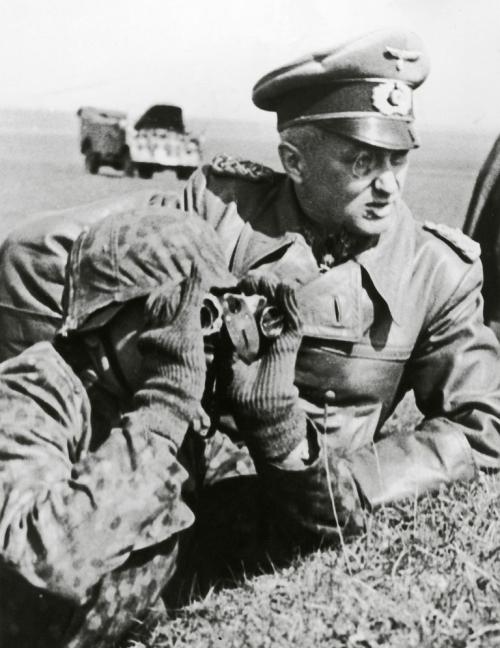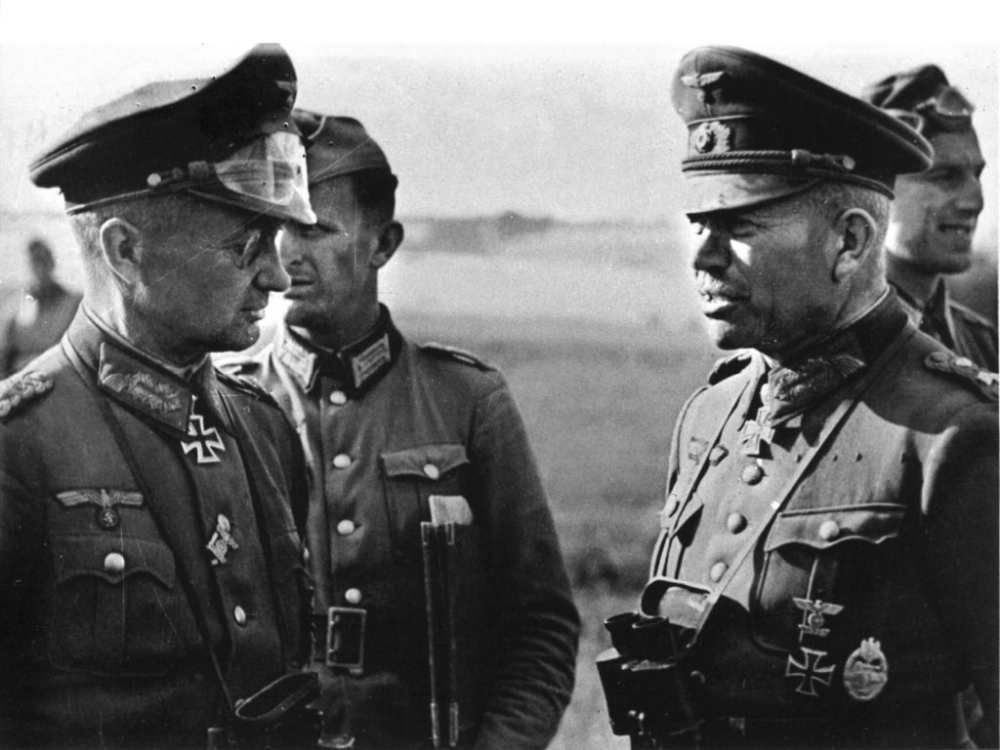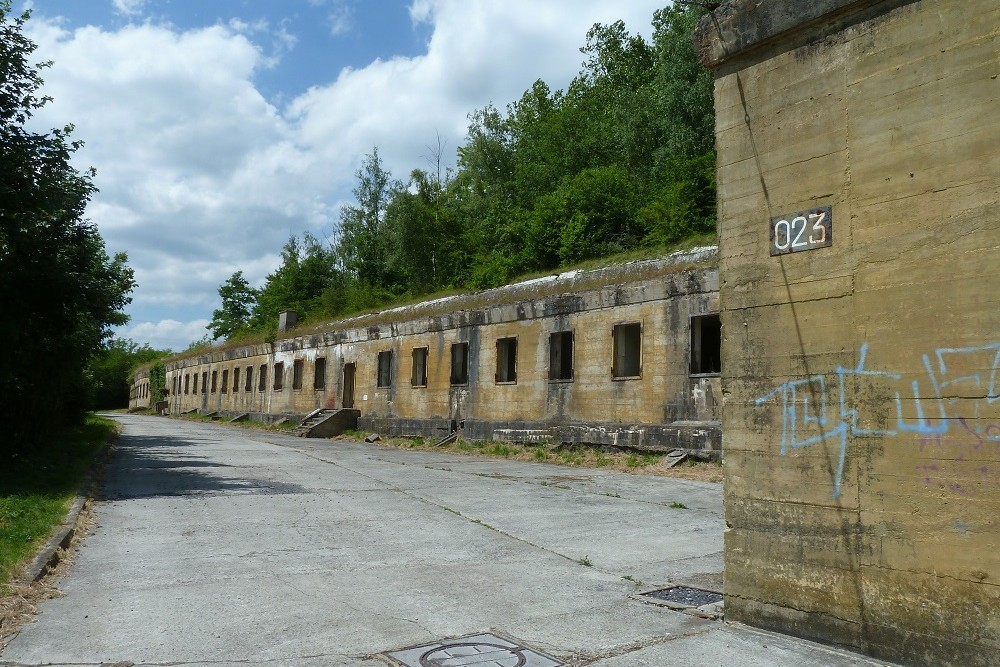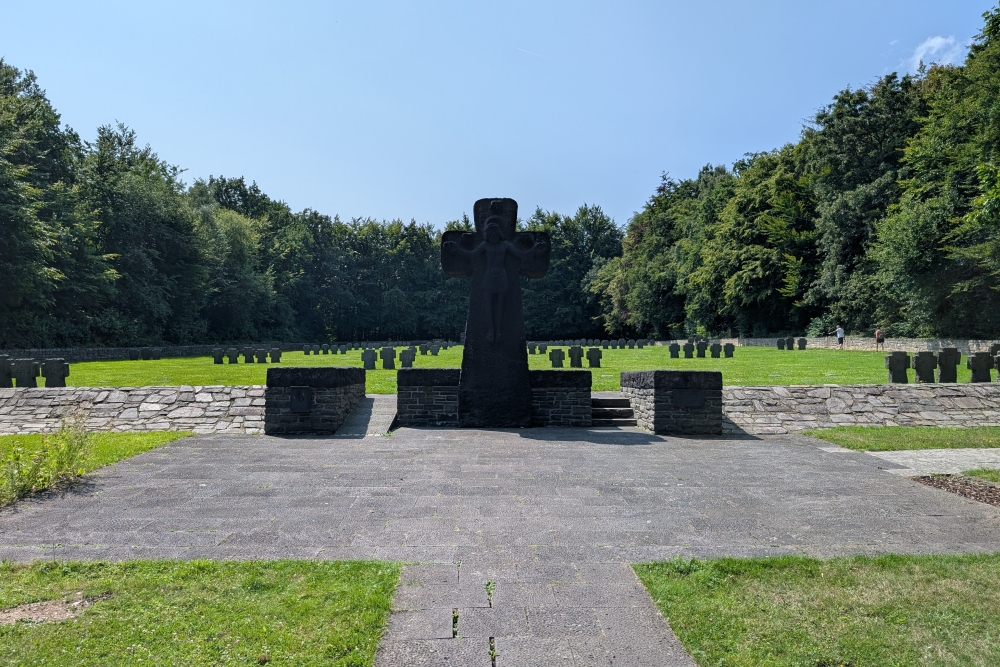Preface
During the Second World War, Walter Model was one of Adolf Hitler’s favourite generals. On more than one occasion he prevented an imminent military defeat on the Eastern front. He was also in command of the German troops who made short work of the British paratroopers during the Battle of Arnhem, an element of Operation Market Garden. Who was this general, who was popular amongst his troops, but didn’t get along with his fellow generals and staff officers?
Definitielijst
- paratroopers
- Airborne Division. Military specialized in parachute landings.
Youth and WW 1
Little is known about the childhood of Otto Mortiz Walter Model. He was born on January 24, 1891 in Genthin (a town in the German state of Saksen-Anhalt), the son of Otto Model and Marie Demmer. He descended from a Lutheran middleclass family. His father was a teacher. The young Walter went to primary school in Genthin and later to high school in Naumburg. On February 27, 1909, he entered the 52nd Infantry regiment Von Alvensleven with the rank of Fahnenjunker. In the same year he visited the Kriegsschule in Neisse (now Nysa in Poland) with the rank of Fähnrich, after which he was promoted to Lieutenant on August 22, 1910. He stood out to his fellow officers due to his boundless ambition and his assertiveness.
When the First World War broke out, Model moved to the Western front with the 52nd Infantry regiment, as part of the 5th Division. Here Model served as Adjutant of the 1st Battalion. On February 25th, 1915, he was promoted to Oberleutnant. In May of that same year he was seriously injured at Arras. Partly for that reason he received the Iron Cross First Class in October. The division headquarters nominated him for an appointment on the general staff, even though Model sometimes refused to follow the orders of his superiors. From April 1916 he took a course to become a Generalstabsoffizier. Consequently he didn’t take part in the battles of Verdun or the Somme, where his unit was decimated. After completion of the course he became Adjutant of the 10th Infantry Brigade, and he subsequently led a company of the 52nd Infantry Regiment and later in the Leib-Grenadier-Regiment ‘König Friedrich Wilhelm III’ (1. Brandenburgisches) Nr. 8. He was again seriously injured.
After Model had recovered from his injuries, on June 7, 1917, he became Ordonnanzoffizier in the Obersten Heeresleitung. There he became Chief of the Operationsabteilung. In this capacity, amongst other things, he made a business trip to Turkey, which at the time was an ally of Imperial Germany. On November 18, 1917, he was promoted to Hauptmann. On March 10, 1918, he became Zweiter Generalstabsoffizier with the Garde-Ersatz-Division.
As staff officer Model was involved in the preparation of the major German spring offensive in 1918 (Operation Michael or ‘Der Kaiserschlacht’). Despite the Germans advancing more than 37 miles in the first weeks, they didn’t manage to break the allied front lines. The troops also had to deal with supply problems. Model commented on this: ‘So many triumphant victories are of no use if there are no supplies.’ In July, supported by fresh American troops, the Allies started a counter offensive. The German soldiers and population could no longer sustain the battle, which also became clear to the highest commanders of the army, Paul von Hindenburg and Erich Ludendorff. When, on November 11, 1918, the ceasefire was signed, Model and many other (lower) officers were however furious and had the feeling that they had been betrayed by the newly appointed civilian government, which had proclaimed the Weimar Republic. They had stopped the fight while, according to him, the war was not yet lost.
After Germany was defeated, as part of the peace treaty agreed at Versailles, it had to limit the army to 100 000 men. In the meantime, Model had built a reputation as a good and capable officer with a lot of potential. That, along with an excellent recommendation from his commander, Generalmajor Franz von Rantau, ensured that he could remain active in the German Army.
Definitielijst
- Brigade
- Consisted mostly of two or more regiments. Could operate independently or as part of a division. Sometimes they were part of a corps instead of a division. In theory a brigade consisted of 5,000 to 7,000 men.
- First World War
- Took place from 1914 till 1918 and is also named The Great War. The conflict started because of increased nationalism, militarism and neo-colonialism in Europe. Two alliances battled one another during the 4-year war, which after a dynamic start, resulted into static trench warfare. The belligerents were the Triple Alliance (consisting of Great-Britain, France, and Russia; later enlarged by Italy and the USA, amongst others) on the one hand and the Central Powers (consisting of Germany, Austria-Hungary, Bulgaria and the Ottoman empire) on the other hand. The war was characterized by the huge number of casualties and the use of many new weapons (flamethrowers, aircraft, poison gas, tanks). The war ended in 1918 when Germany and its allies surrendered unconditionally.
- Infantry
- Foot soldiers of a given army.
- Iron Cross
- English translation of the German decoration Eisernes Kreuz.
- offensive
- Attack on a smaller or larger scale.
- regiment
- Part of a division. A division divided into a number of regiments. In the army traditionally the name of the major organised unit of one type of weapon.
- Weimar Republic
- Name for the German republic from 1919 until 1933. Hitler ended the Weimar republic and founded the Third Reich.
Rise of the Third Reich
During the bloody and turbulent early years of the Weimar Republic, Model distanced himself from politics. His standard view was that politics should be left to the politicians. As commander of a company in the 14th Infantry regiment, he was involved in the violent suppression of a communist uprising in the Ruhr area in April 1920. In 1921 he was appointed as a Generalstabsoffizier in Münster on the general staff. Although the Treaty of Versailles prohibited the establishment of such a commanding authority, the Germans did not comply with it. That same year, on May 12, Model married Herta Huyssen. They had three children: Christa, Hella and Hansgeorg. His son (1927-2016) would later also have a military career and rise to the rank of Brigadier General in the Bundeswehr.
In 1925 Model was appointed to a staff function with the 8. (Preussische) Infanterie-Regiment. For this he relocated to Görlitz. During this period, he wrote a biography about the famous Prussian officer, August Neidhardt von Gneisenau (1760-1831). From 1928 he taught tactics and warfare as part of the basic courses for Generalstabsoffiziere in Berlin. In 1930 he was transferred to the training section of the Truppenambt, the equivalent of the general staff in the Weimar Republic. In this capacity he travelled to the Soviet Union in 1931. During that time, the armed forces of Germany and the Red Army were cooperating in a number of areas. In 1929 Model was promoted to Major and in November 1932, to Oberstleutnant.
After Adolf Hitler came to power in Germany, the German army was significantly expanded. In 1933 Model led a batallion of the 2. Infantry-Regiment in Allenstein (East-Prussia). On October 1, 1934, his promotion to Oberst followed after which he gained command of the 2. (Prussian) Infanterie-Regiment. In 1935 Model was added to the Generalstab des Heeres where he was given command of the technical department. Here he was involved, amongst other things, in the development of the Sturmgeschütz, a self-propelled assault gun that served as support to the infantry. On November 10, 1938, Model, with the rank of General Major, was appointed as Chief of Staff of the IV. Armeekorps. As part of the 10. Armee he was involved with this unit in the attack on Poland that started on 1 September 1939.
Definitielijst
- batallion
- Part of a regiment composed of several companies. In theory a batallion consists of 500-1,000 men.
- Infantry
- Foot soldiers of a given army.
- Red Army
- Army of the Soviet Union.
- regiment
- Part of a division. A division divided into a number of regiments. In the army traditionally the name of the major organised unit of one type of weapon.
- Soviet Union
- Soviet Russia, alternative name for the USSR.
- Weimar Republic
- Name for the German republic from 1919 until 1933. Hitler ended the Weimar republic and founded the Third Reich.
Start of WW 2
On October 13, 1939, Model was appointed as Chief of Staff of the newly formed 16. Armee that was under the command of General der Infanterie, Ernst Busch. With this unit he took part in the Battle of France. The 16. Armee was part of the advance on Luxemburg and the fighting and breakthrough at the French city of Sedan. After the encirclement battles at Epinal and Nancy they advanced up to the Swiss border. One month earlier, on April 1, 1940, Model was promoted to Lieutenant General. After that, Model was involved with the preparations for the attack on Great Britain. The plan of attack, with code name Seelöwe (Sea Lion), was canceled because the Luftwaffe failed in eliminating the British R.A.F. during the Battle of Britain.
Due to his performance as Chief of Staff, Model was given command of a division, namely the 3. Panzer-Division, for the first time. He immediately implemented a major reorganisation of the command structure, much to the annoyance of his staff. He also caused upheaval by making his troops follow a combined training program in which, for example, members of the infantry, tank crew members and supply troops were combined in improvised units. The German army would make much use of these combined units or Kampfgruppen later in the war, but in 1940 it was very progressive.
Definitielijst
- infantry
- Foot soldiers of a given army.
- Luftwaffe
- German air force.
Invasion of the SU
In June 1941, as SS Commander of the 3. Panzer-Division, Model took part in Operation Barbarossa, the German invasion of the Soviet Union. The 3. Panzer Division was assigned to Heeresgruppe Mitte and came under Panzergruppe 2. Model advanced quickly with his division and on July 4 they reached the banks of the Dnjepr. Here however, he encountered heavy opposition from the Russian 21st army. On July 10, Model started to cross the river. For this he divided his troops into three groups. One group of infantry men had to cross the river and establish a bridgehead. The tanks had to exploit the momentum by advancing further. Model had all his artillery concentrated on one spot to give fire support. The river crossing was enormously successful. After that, a heavy battle followed. In the large encirclement assault at Bialystok and Minsk in which the 3. Panzer-Division took part, the 3rd and 4th Soviet armies were destroyed. After the encirclement followed the major breakthrough to the east where Model’s unit fought fierce battles at Lutsk, amongst others. Because of his great achievements as a commander, Model was subsequently awarded the Ritterkreuz.
After the fall of Smolensk, Adolf Hitler decided to send the Panzergruppe 2, led by Generaloberst Heinz Guderian von Heeresgruppe Mitte, to the south to conquer the Ukraine. The 3. Panzer-Division was the spearhead of this advance that was intended to surround the Soviet troops near Kiev. From August 24 to September 14, Model advanced 171 miles. After meeting the 16. Panzer-Division at Lokhvita, the ring was closed. This encirclement produced a large number of prisoners of war. Due to his performance, Model was given put in command of the XXXXI. Panzerkorps. Moreover, on October 26, he was promoted to the rank of General der Panzertruppe.
Model arrived at his new command post, near Kalinin on November 14, 1941. The corps were involved in the advance and the Battle of Moscow, Operation Taifun, that was launched on October 2. Despite the falling temperatures, the advance went well. As a result, he was often absent from this headquarters. On December 5, units of the XXXXI Panzerkorps reached Iohnca, 22 miles from Moscow. Here the advance stopped due to bad weather. The German weapons and vehicles were not designed for temperatures of 20 to 40 degrees below zero. Subsequently, the Red Army launched a massive counter attack on December 5. In the weeks following, the German troops were pushed to the West by more than 124 miles and panic broke out. However, Model managed to maintain order, allegedly by keeping his troops under control with his gun drawn.
Model developed a defence tactic by dividing his troops into a few strong positions. He also created mechanised Kampfgruppen that had to deal with the Russian breakthroughs. His tactic worked, but at a high cost to human lives. One division in his corps lost more than 1,000 men in the winter of 1941.
Definitielijst
- Heeresgruppe
- The largest German ground formation and was directly subordinate to the OKH. Mainly consisting of a number of “Armeen” with few directly subordinate other units. A Heeresgruppe operated in a large area and could number several 100,000 men.
- infantry
- Foot soldiers of a given army.
- invasion
- Armed incursion.
- Red Army
- Army of the Soviet Union.
- Soviet Union
- Soviet Russia, alternative name for the USSR.
Rzhev
Although the Germans managed to stabilise the front, the Russian army continued to advance elsewhere. The situation was particularly bad in the salient near Rzhev, about 143 miles West of Moscow. The German 9. Armee, under the command of Generaloberst Adolf Strauss, was in danger of being surrounded by the Soviets. Model, who had fought well thus far, was subsequently charged with command on January 16, 1942. Prior to this appointment he had had several conversations with Adolf Hitler and Generalstabchef Generaloberst Franz Halder. Model declared on this occasion that he wanted to prevent the situation in the salient by launching an attack. Hitler was very impressed by the steadfast and powerful appearance of the young general. He apparently mentioned: "did you see that eye? I trust the man to do it but I wouldn’t want to serve under him."
By launching a counter attack, he confused the enemy troops and managed to stabilise the front. Model even succeeded in surrounding the 39th army. The Soviet soldiers, however, didn’t just give up and literally fought themselves to death. For this performance, Model was awarded the Eichenlaub with his Ritterkreuz on February 17 and was promoted to Generaloberst on February 28. Model managed to hold the salient for the rest of 1942. He did this by using his own defence tactics. By having reconnaissance missions carried out, he always had an accurate picture of the enemy. He centralised his artillery into specialised units which were directly under the command of the corps or division headquarters. With other units in the German army, this was decided on at regimental level. Thanks to the central control, more firepower could be concentrated on a specific point. He also often worked with several static lines of defence, in spite of the order from Adolf Hitler who banned several lines in succession, because it would make soldiers more inclined to give up a position. However, Model held on to a number of lines in succession, even though these were sometimes sparsely occupied. Model also always made sure that there were tactical reserves to stop any enemy breakthrough. These reserves were often formed by splitting units into smaller groups, something that military strategists advised against.
On May 25, 1942, during a reconnaissance flight over the front, Model was wounded by the bullet of a Soviet sniper. His left lung was punctured and an emergency operation saved Model’s life. While he was recovering in Germany, the Russian Western front, under the command of General Georgy K. Zhukov, and the Kalinin front, under the command of General Ivan S. Konev, launched a large-scale attack on the sailent of Rzjev whereby the 9. Armee came under heavy pressure. On August 10, 1942, Model returned to the army headquarters. He quickly managed to redress the situation by, amongst other things, deploying improvised units that consisting of walking wounded. The British historian, Sir Basel Liddell Hart later wrote about Model, that he had the special ability to form a reserve on an almost empty battlefield. He managed to stop the offensive, at the expense of very heavy losses. Zhukov did not give up. In November he tried again, with a new offensive under code name ‘Operation Mars’. However, Model again proved himself as a skilled defender and the Russian troops made little progress in their large-scale frontal attacks and suffered many losses.
Due to the heavy attacks, the German army wasn’t able to transfer troops from the central sector of the front to the southern sector at Stalingrad where a military catastrophe was unfolding. After the encirclement of the German 6. Armee, led by Generalfeldmarschall Friedrich Paulus, the Red Army had taken over the strategic offensive at Stalingrad and seized a lot of territory. In March 1943, as part of a shortening of the front line, Model was ordered to evacuate the salient. Before he did that, he gave the order to deport the entire male population from the sector. He also enforced the scorched earth tactic; many towns were burnt to the ground. Model was subsequently designated by the Allied powers as a war criminal. Hitler, however, greatly appreciated the "Lion of Defense", a nickname Model received after Rzhev, and awarded him the Schwertern along with his Ritterkreuz. The fighting at Rzhev had claimed the lives of more than 350,000-400,000 Germans. On the Russian side, the losses amounted to around 2,000,000.
Definitielijst
- offensive
- Attack on a smaller or larger scale.
- Red Army
- Army of the Soviet Union.
- sniper
- Military sniper who can eliminate individual targets at long distances (up to about 800 meters).
Operation Citadel
n the summer of 1943, Adolf Hitler once again tried to take over the initiative on the Eastern front by a large-scale attack on the salient, on the Russian front at Kursk. If this buldge could be squeezed out, the front would be considerably shortened. The high command of the Red Army was aware of the German plans, partly by espionage, and strengthened the front in this location. The offensive would be led by Generalfeldmarschall Erich von Manstein, the commander of Heeresgruppe Süd. He wanted to attack in April/May, but because Hitler remained hesitant, ‘Operation Zitadelle’ started as late as July 5, 1943. The delay was partly caused by the fact that Hitler wanted the new type of tanks, the PzKpfw V Panther and PzKpfw VI Tiger, to be deployed in this battle. Model had his doubts about the attack because of the advantage of men and equipment his opponent, army general KHonstantin K. Rokossovsky, commander of the Central front had.
Generaloberst Walter Model had command of the Northern attack point in the large offensive. Under his command were 14 infantry divisions and 4 tank divisions. The attack was planned for the morning of July 5, 1943. A German prisoner had informed the Russians of the planned attempt by the German army to destroy the salient. They attacked the German units just before their start. This meant that the offensive had to be postponed for two hours. The German assault troops were led by the so-called ‘Panzerwiggen’, (armored wedge) tank battalions that consisted of heavy tanks of the PzKpfw VI Tiger type and a few Ferdinand tank-destroyers. Model managed to advance 6 miles in the first days, but his formations suffered heavy losses. The infantry could not keep up with the Panzerwiggen and the Ferdinands were eliminated by anti-tank mines. The new Tigers didn’t have a machinegun, so they could do little against the infantry. On July 7, Model deployed his reserves in an attempt to force a breakthrough. The Central Front, led by Konstantin K. Rokossovsky, managed to halt the attack, aided by its numerical dominance, under very heavy losses. From July 5 – 8, the 9. Arrmee lost 20,000 men and 200 tanks.
After the failure of the attack, a major Soviet counter attack followed on July 12. The 2nd Army, led by General Ivan C. Bagramjan, fell in behind Model at Orjolaan and advanced 11 miles. However, it was not possible to split the German troops, which was the purpose of Bagramjan. With his defense tactics, Model managed to inflict heavy losses on the Red Army. On July 13, Hitler discussed the situation with Von Manstein en Generalfeldmarschall Günther von Kluge, the commander of Heeresgruppe Mitte. Erich von Manstein wanted to carry on with the attack but Kluge argued that the position of the 9. Armee was untenable. On July 22, Hitler gave Model permission to evacuate the Orjol-salient. Just like in Rzjev, this was again accompanied by Germans destroying anything that could be of use to the enemy. 250,000 citizens were also deported. Model established his headquarters on the banks of the Dnjepr. In September 1943, Hitler relieved Model from his function and he went to Dresden for two months to spend time with his family. Historians suspect that Hitler granted Model some respite after the past hectic months. He also kept Model out of another crisis situation.
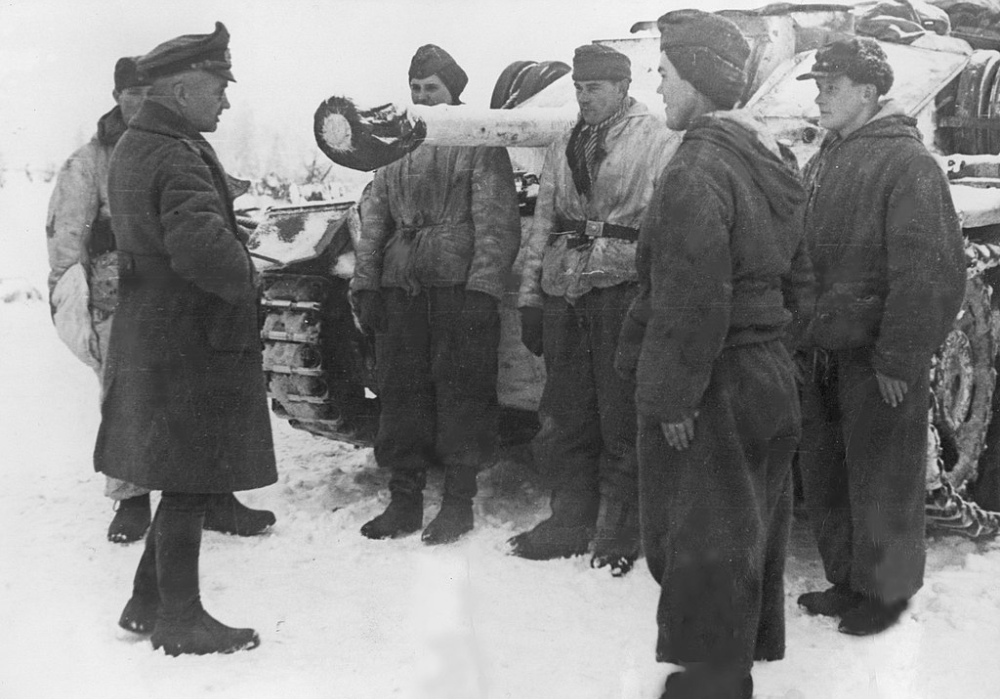
Walter Model talking with the crew of a StuG III Ausf G on the Eastern front, January 1943. Source: Pools Nationaal Archief
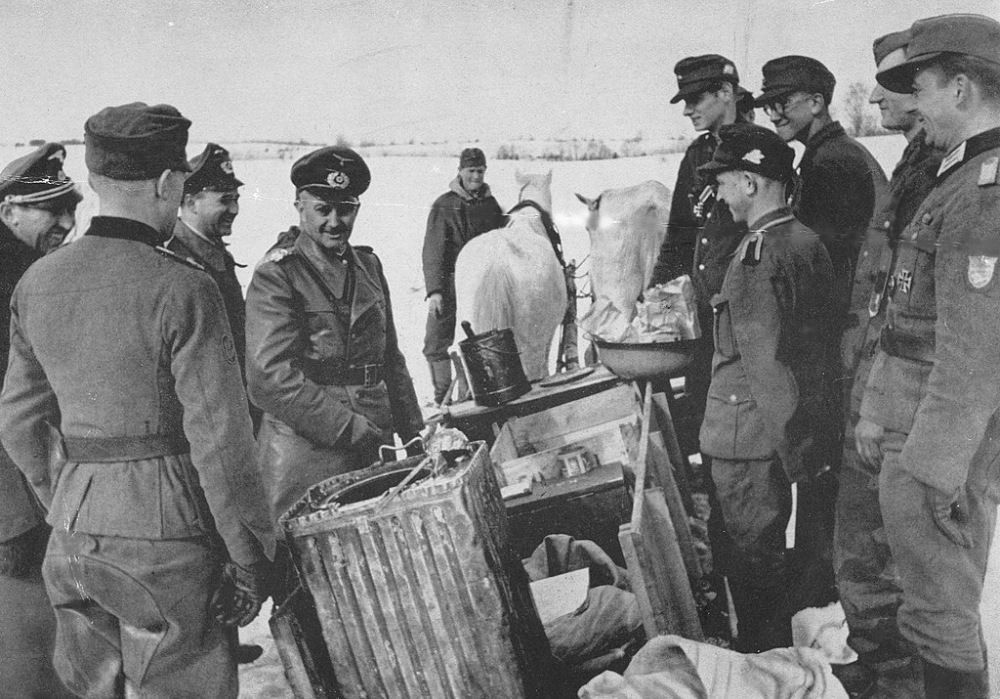
Walter Model surrounded by artillery soldiers near a horse-drawn field kitchen on the Eastern front, April 1944. Source: Pools Nationaal Archief
Definitielijst
- Heeresgruppe
- The largest German ground formation and was directly subordinate to the OKH. Mainly consisting of a number of “Armeen” with few directly subordinate other units. A Heeresgruppe operated in a large area and could number several 100,000 men.
- infantry
- Foot soldiers of a given army.
- offensive
- Attack on a smaller or larger scale.
- Red Army
- Army of the Soviet Union.
Hitler's firefighter
This crisis situation arose at the start of 1944. On January 14, 1944, the Red Army launched a large offensive to break the siege of Leningrad. The supreme commander of Heeresgruppe Nord, Generaloberst Georg von Küchler, asked Hitler for permission to abandon the German positions and to establish a more defensible line. Hitler then dismissed him and replaced him with his favourite, Model. Model probably also saw that the battle for Leningrad and the war in general couldn’t be won. In January 1944 he described the situation on the Eastern front as ‘fighting backwards’.
Initially, Model didn’t manage to stop the onslaught of the Soviets, who advanced about 124 miles up to the border of Estonia. He decided to rely on a new tactic, "Shield and Sword". Hereby the area was ‘temporarily’ handed over. Then, reserves were assembled to recapture the area in a counter attack. Partly due to a lack of reserves, a recapture in the Northern sector of the Eastern front never materialized. Model ordered his troops to retreat to the Panther line. With this he actually did what Von Küchler had previously proposed and for which he had been sacked. In part by carrying out local counterattacks, Model managed to inflict heavy losses on the Red Army. With his aggressive defence strategy he made a great impression on Hitler. This resulted in his appointment as Generalfeldmarschall on March 1, 1944. At 53 years of age he was one of the youngest marshals in the German armed forces.
After this, Model replaced Erich von Manstein as commander of Heeresgruppe Northern-Ukraine. The area wasn’t in German hands but Model had to recapture it. However, he too could not stop the Russian advance, let alone conquer the Ukraine.
In June 1944, the Red Army, in conjunction with the Americans and he British who landed on June 6 in Normandy, started ‘Operation Bagration’, the large-scale summer offensive. The Germans were driven hundreds of miles to the West in disarray by the attack. On June 28, Hitler dismissed Generalfeldmarschall Ernst Busch as commander of Heeresgruppe Mitte and replaced him with Model. At that time the 4. and 9. Armee were surrounded. Model’s plan was to shorten the front line and thereby free up reinforcements, with which the 4. Armee could break out of its encirclement. However, Hitler didn’t give permission for this and on July 3 Minsk was liberated by the Red Army. The 4. Armee was destroyed. Model managed to establish a line at the Berezina river, which held out for some time. After that the German army had to cross it at lightning speed to avoid being surrounded. Model only managed to stop the Russians very close to Warsaw. Supply problems played an important role in the Red Army due to the longer supply lines. On August 17, he was awarded the Brillanten with his Ritterkreuz. Hitler labelled Model as "My best field marshal" and "The saviour of the Eastern front."
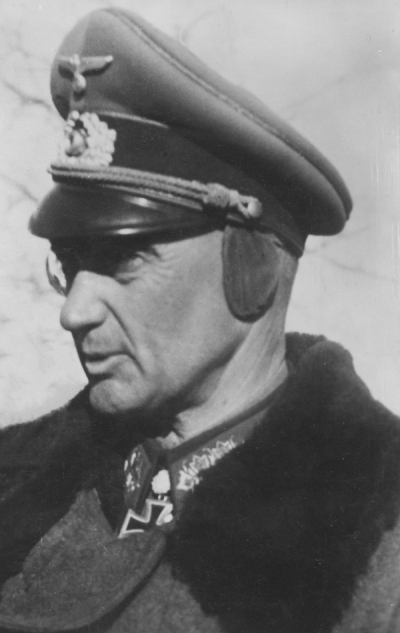
The general in battledress and his typicle monocle and Knight’s Cross. Source: Pools Nationaal Archief
In 1944 Model had all three Heeresgruppen on the Eastern front under his command. Because the little Generalfeldmarschall were always transferred by Hitler to another front where a breakthrough was imminent, Model got the nickname of "Hitler’s Firefighter". Hitler appreciated Model because the small, stocky field marshal with his monocle, was far from the typical Prussian aristocratic officer. He was from humble decent and remained a common man. SS-Standartenführer Lingner wrote about him: "Model is a conceited and exuberant man, always has ideas and at least three solutions for a perilous situation."
Definitielijst
- Heeresgruppe
- The largest German ground formation and was directly subordinate to the OKH. Mainly consisting of a number of “Armeen” with few directly subordinate other units. A Heeresgruppe operated in a large area and could number several 100,000 men.
- marshal
- Highest military rank, Army commander.
- offensive
- Attack on a smaller or larger scale.
- Red Army
- Army of the Soviet Union.
- strategy
- Art of warfare, the way in which war should be conducted in general.
Market Garden and the Ardennes offensive
After the break out from Normandy, the American and British armies advanced relentlessly and it seemed only a matter of time before they would reach the Siegfried Line. Hitler had no confidence in the Supreme commander in the west and Heeresgruppe B, Günther von Kluge. He suspected his involvement in the attack and coup on July 20, 1944, and of secret negotiations with the Allies. The command of Heersgruppe B was therefore transferred to Model and on August 15, Hitler ordained that Model had to replace Von Kluge as Oberbefehlshaber West. He held this position until Generalfeldmarschall Gerd von Rundstedt took over from him on September 5, 1944.
Model managed to stabilise the situation. He asked, and received permission from Hitler to let 50,000 soldiers of the 7. Armee escape from the encirclement at Falaise. It was, among others, these soldiers who would put up fierce resistance at the Battle of the Scheldt later that year. Lieutenant General Omar Bradley, commander of the 12th Army Group, declared that ‘Generalfeldmarschall Model miraculously gave the German troops a new backbone and stopped the panic.’
When Hitler demanded that Paris remain in the hands of the German army, Model answered by saying he could achieve that if he received 200,000 men and multiple armoured divisions as reinforcement. These reinforcements didn’t arrive and on August 25, Paris was liberated by the 2ième Division Blindée under the command of Géneral de division Jacques-Philippe Leclerc.
After the Allied troops drove the Germans out of Belgium at the beginning of September, and crossed the Bocholt-Herentals canal, Model established the Heeresgruppe B headquarters in hotel De Tafelberg in Oosterbeek. His heavily battered units had to rest and recover here. On September 15, Model’s superior Von Rundstedt, wrote to Generaloberst Alfred Jodl, chief of the Wehrmachtführungsstab: ‘The situation has further deteriorated for the Heeresgruppen B in the last week. They are fighting on a front of about 249 miles with a combat strength of about twelve divisions and currently 84 usable tanks, mechanized guns and light tank hunters against a fully mobile enemy with at least 20 divisions and around 1,700 usable tanks.’ Then he requested reinforcements for this army group.
Model was alerted by several German officers that the Allies might try to seize the bridges over the Rhine by means of airborne attack. However, he dismissed these warnings because he thought this plan to be too risky for Bernard Montgomery, the ‘careful’ British Field Marshall.
On September 17, 1944, while Model and his staff were at lunch, they were disturbed by the landing of gliders and parachutists of the British 1st Airborne Division. His Chief of Staff, Generalleutnant Hans Krebs allegedly remarked, "This became the defining battle of the war", to which Model replied: ‘Don’t exaggerate. It’s clear, get to work Tempelhof’. Oberst Hans von Tempelhof was de Chief of Operations of Heeresgruppe B.
Model and his staff hastily left the hotel De Tafelberg and established themselves at Castle Wisch in Terborg. He assumed that the parachutists’ goal was to capture or kill him. Historians labelled this as a token of Model’s self-righteousness. It quickly became apparent to the Germans that the British 1st Airborne Division, who were deployed in aid of ‘Operation Market Garden’, had the goal of taking the bridge over the Rhine at Arnhem.
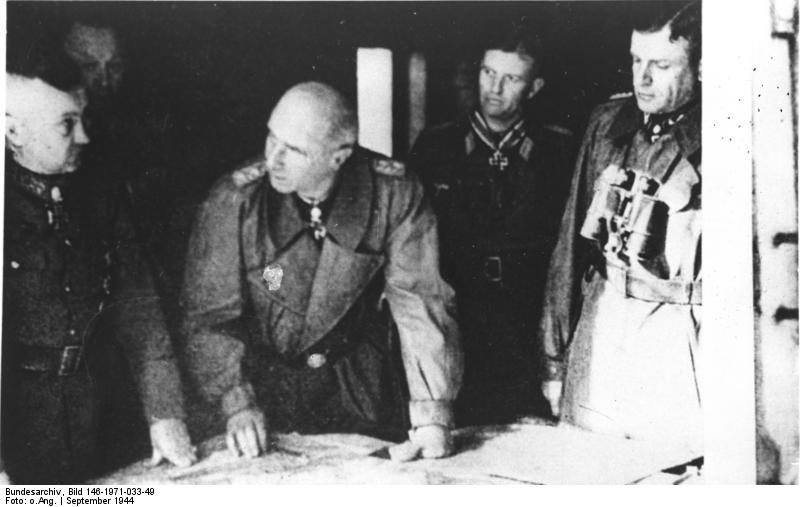
Meeting during the battle of Arnhem. F.l.t.r. Walter Model, Kurt Student, Wilhelm Bittrich, Hans Peter Knaust and Heinz Harmel. Source: Bundesarchiv, Bild 146-1971-033-49 / CC-BY-SA 3.0
Model was therefore in the perfect position to deal with this. He sent the 10. SS-Panzer-Division, under command of Brigadeführer Heinz Harmel, to Nijmegen to prevent the Allied ground troops from reaching the parachutists. The 9. SS-Panzer-Division, commanded by SS-Obersturmbahnführer Walter Harzer, was given orders to defend the bridge at Arnhem and eliminate the British parachutists. Both divisions fell under the II. SS-Panzerkorps. After defeating the airborne troops, Model hoped to start a counter offensive to drive the Allies out of the southern part of the Netherlands. At his request, the bridges at Nijmegen weren’t destroyed since the Germans would need these in any counter attack. He did however give the order to destroy the port at Rotterdam. Hitler was furious when the road bridge was seized by the Allies on September 20, and demanded an explanation as to why it wasn’t destroyed. Model admitted that he was responsible for the bridge not being blown up. The historian Anthony Beevor remarked that only Model could ignore Hitler’s orders at this stage of the war and get away with it.
Model made daily visits to the command posts of each unit involved, from both the division and every Kampfgruppe. Harzer described that he first required a report of the current situation. If any problems arose, the local commander first had to come up with three solutions themselves. Only then could they submit requests to the Generalfeldmarschall. Model did everything to accommodate his troops. He ensured that transports to the battlefields in Arnhem and Nijmegen were given the highest priority on German railways. For example, when the troops requested flamethrowers for the street battles, he had these flown in.
Model remained a top military officer. When he learned that SS-Obergruppenführer Wilhelm Bittrich, the commander of the II. SS-Panzerkorps had agreed to a temporary ceasefire to allow the British to evacuate their heavily wounded men from Oosterbeek, he was furious. According to him the enemy benefitted from the ceasefire. But Model protected Bittrich by not mentioning this action to Hitler.
After the victorious battle, Model ordered the evacuation of Arnhem and the surrounding area. 150,000 people were forced to leave their homes. The Germans claimed that this order was given to protect the citizens against combat operations. However, this order was given when the battle in Arnhem and Oosterbeek had already been decided in favour of the Germans. In reality, the order was a part of the retaliation against the civilian population. The Dutch were being punished for the enthusiasm with which they had welcomed the Allied troops and the assistance they had offered them during Operation Market Garden.
After the victorious battle of Arnhem, Model gave the order that the Betuwe had to be recaptured. The German attacks, which were started at the beginning of October, were unsuccessful because of the British opposition. Subsequently, defensive positions were set up by the Germans, east of Arnhem along the IJssel.
From September to December, the units of Heersgruppe B were involved in heavy battles with the 12th Army Group in the Húrtgenwald and around Aachen. Model had reinforced the Siegfried Line again and this now became a difficult obstacle. Model applied his proven defence strategy. It took the whole of October before the Americans broke through the line after heavy fighting and at the expense of more than 30,000 dead and wounded.
On November 3, 1944, Model, along with other high Generals were briefed about the ‘Ardennes Offensive’ by Generaloberst Alfred Jodl, Commander of the Armed Forces Joint Staff. He described it as a plan that had no leg to stand on. Yet, he fully devoted himself to the success of the attack. He was convinced that the defensive attitude that the Germans had adopted after the outbreak from Normandy only delayed the defeat. He was in favour of an attack, but on a smaller scale. Model pleaded with Alfred Jodl several times in vain for the small solution (an offensive in the direction of Liège). Hitler, however, insisted on the large-scale offensive, the objective of which was to recapture the port of Antwerp. During a telephone conversation, the general became so enraged that he exclaimed: "You can tell that Fuehrer of yours that Model will not carry out such an order." In the end, however, he went overboard and even earned praise from the other generals for his preparation for the attack in the Ardennes. For this, the last of the German reserves were thrown into battle. However, the troops suffered from a major lack of materials and equipment. When one of his subordinate officers complained about this, he remarked that if he needed something then he should just have to take it from the Americans.
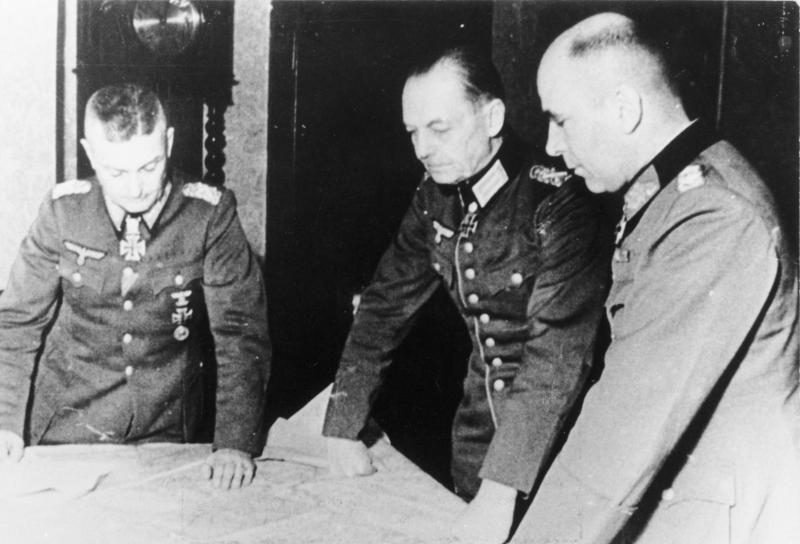
F.l.t.r..Walter Model, Gerd von Rundstedt and Hans Krebs during a preparatory meeting prior to the Ardennes offensive, November 1944. Source: Bundesarchiv, Bild 146-1978-024-31 / CC-BY-SA 3.0
When Oberst Friedrich August von der Heydte argued that an attack with parachutists under his command, as part of the operation had only a small chance of success, Model stated that the attack had to be carried out because the whole offensive had only a 10% chance of success. ‘It has to be done, it’s the last remaining chance to end the war favourably’. On December 13, he remarked to SS-Oberstgruppenführer Josef Dietrich, that the ‘Ardennes Offensive’ was the worst planned German offensive of the entire war. In one of his daily statements to Heeresgruppe B however, he noted: ‘We will be victorious because we believe in Adolf Hitler and the Great German Reich.
The Ardennes Offensive’ started on December 16, 1944. In the first days the Germans advanced miles. The advance was however delayed due to traffic congestion and difficult terrain. When Model noticed that a few units were not advancing, he gave the order to bring the commanding officers before a court martial. He revoked the order when it became apparent that the soldiers simply couldn’t go forward any faster. During one of his visits to the front, Model became so frustrated with the congestion that he took to the road and began directing traffic himself. Partly because the traffic junction at Bastogne was not seized, the successes of the first days could not be exploited. On December 25, the attack stopped due to a lack of air support and limited fuel reserves. On January 8, 1945 the ‘Ardennes Offensive’ was officially ended.
Definitielijst
- Ardennes Offensive
- Battle of the Bulge, “Von Rundstedt offensive“ or “die Wacht am Rhein“. Final large German offensive in the west from December 1944 through January 1945.
- Heeresgruppe
- The largest German ground formation and was directly subordinate to the OKH. Mainly consisting of a number of “Armeen” with few directly subordinate other units. A Heeresgruppe operated in a large area and could number several 100,000 men.
- Kampfgruppe
- Temporary military formation in the German army, composed of various units such as armoured division, infantry, artillery, anti-tank units and sometimes engineers, with a special assignment on the battlefield. These Kampfgruppen were usually named after the commander.
- offensive
- Attack on a smaller or larger scale.
- resistance
- Resistance against the enemy. Often also with armed resources.
- strategy
- Art of warfare, the way in which war should be conducted in general.
Downfall of the Third Reich and death
Model managed to withdraw some of his troops behind the Siegfried Line and thereby could continue the battle. Due to the failure of the Ardennes Offensive however, Hitler lost confidence in Model. He greatly restricted his freedom by insisting that all divisions of the Heersegruppe B personally report to the Fuhrer from then on. It was strictly forbidden for Model to give any ground away for tactical manoeuvres. After the Ardennes Offensive, Hitler decided to replace Von Runstedt as Oberbefehlshaber West. Generalfeldmarschall Wilhelm Keitel, Chief of the Oberkommando der Wehrmacht, argued in favor of giving Model this position. After all, he knew the entire front. However, Hitler refrained from this. According to Keitel, because Hitler wanted to make Model the scapegoat for the failure of the offensive. Eventually Albert Kesselring was given command in the west. For that he had to come over from Italy. At the end of January 1945, Model was visited by his son at the front. Hansgeorg later wrote that as he left he was gripped by the realization that he would never see his father again. Model sunk even lower in Hitler’s estimation when on March 7, 1945, the bridge over the Rhine at Remagen fell into American hands, unscathed. Yet, Model continued the fight. To his officers he professed: ‘The victory of national socialism is beyond doubt. The decision lies in our hands.’ He also had a number of deserters arrested and summarily executed.
At the beginning of April, the Heeresgruppe B was surrounded in the Rhineland by the 1st and the 9th Army. Hitler declared the area as a stronghold. The troops were not allowed to surrender or break out. Hitler also ordered that, in line with the Nero-order, all infrastructure in the Ruhr area be destroyed. Model however didn’t comply with this order. The battle for the area was relatively short. On April 15, the army group was split in two by an attack. Responding to a request from Major General Matthew Ridgway to surrender, Model stated that a formal capitulation was out of the question because of his oath to the Fuhrer and his honour as Generalfeldmarschall. Model did disband the Heerengruppe however. The oldest and youngest solders were discharged from military service. The rest of the soldiers could choose between surrender or to break out and join the fighting units. The vast majority chose to surrender.
On April 17, 1945 approximately 325,000 soldiers surrendered to the Americans. That caused the Minister of Propaganda, Joseph Goebbels, to label the soldiers of Heeresgruppe B as traitors to the Empire. Model didn’t want to end up alive in the hands of the enemy, like Generalfeldmarschal Friedrich Paulus, after the battle for Stalingrad. To his staff members he remarked: ‘What remains for a commander after a defeat? They took poison in ancient times.’ When Model learned that the Russians were looking for him for war crimes, including the deportation of people to do forced labour, his decision was made. On April 21, 1945, in the area of Duisberg, Model walked into the woods and shot himself.
Model initially received a field grave at his own request. In 1955 his body was exhumed and reburied in the military graveyard at Vossenack.
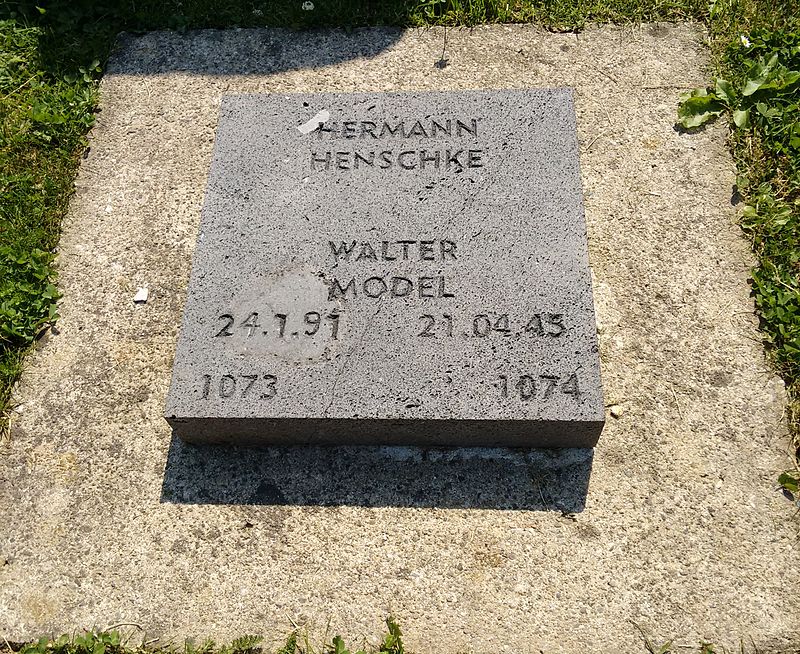
Final resting place of Walter Model on the military cemetery at Vossenack. Source: Wikimedia Commons
Definitielijst
- Ardennes Offensive
- Battle of the Bulge, “Von Rundstedt offensive“ or “die Wacht am Rhein“. Final large German offensive in the west from December 1944 through January 1945.
- capitulation
- Agreement between fighting parties concerning the surrender of a country or an army.
- Heeresgruppe
- The largest German ground formation and was directly subordinate to the OKH. Mainly consisting of a number of “Armeen” with few directly subordinate other units. A Heeresgruppe operated in a large area and could number several 100,000 men.
- national socialism
- A political ideology drawn up by Hitler based on the superiority of the German race, the leader principle and fierce nationalism that was fed by the hard Peace of Versailles. National socialism was anti-democratic and racist. The doctrine was elaborated in Mein Kampf and organised in the NSDAP. From 1933 to 1945 National socialism was the basis of totalitarian Germany.
- Offensive
- Attack on a smaller or larger scale.
- Propaganda
- Often misleading information used to gain support among supporters or to gain support. Often used to accomplish ideas and political goals.
- Rhineland
- German-speaking demilitarized area on the right bank of the Rhine which was occupied by Adolf Hitler in 1936 after World War 1.
- socialism
- Political ideology aiming at slight or no class differences. Means of production are owned by the state. Evolved as a response to capitalism. Karl Marx tried to substantiate socialism scientific.
- war crimes
- Crimes committed in wartime. Often concerning crimes committed by soldiers against civilians.
- Wehrmacht
- German armed military forces, divided in ground forces, air force and navy.
Epilogue
The opinions about Generalfeldmarschall Walter Model among his subordinates varied. Generally he was seen as a thorough and competent leader, but his fellow soldiers also resented him because he expected too much from his officers and soldiers and thought that he sometimes lost sight of what was practically possible. One regimental commander of the 17. SS-Panzer Grenadier-Division typified him as the ‘gravedigger of the Wester front’. His colleague, SS-Obersturmbahnführer Lönholdt, on the contrary, called him ‘a first-class improviser and a very cold-blooded man who is extremely popular with his men, because he has a certain amount of feeling for them and does not put himself in the spotlight with much fuss.’
Model's relationship with his staff was difficult, partly because he demanded the same from them as from himself, such as regular visits to the front. He was known for not letting them finish talking. SS-Standartenführer Lingner said about Model: ‘He is an absolute autocrat. He doesn’t tolerate any contradiction.’ Model often berated and insulted subordinate officers in public, which was seen as a terrible disgrace in military circles. He always claimed successes for himself. He rarely nominated subordinates for an award. Some therefore described him as a ‘mini Hitler’. Erwin Rommel stated that when Model was appointed as Commander of the XXXXI Panzerkorps, all the staff members requested to be transferred to other units. His disdain of bureaucracy and etiquette and the fact that he often visited the front, sometimes joining in the attack with a drawn pistol, meant that he was popular amongst the ordinary soldiers.
Model proved himself to be a skilled soldier at the battles of Rzhev, Orjol and on the Western front in 1944. He was seen as one of the best Generals of the Third Reich, especially in the field of defensive warfare.
He saw himself as a non-political soldier, but this opinion is not shared by his fellow generals and subordinates. Just how much of a supporter of the Nazi ideology he was, is not clear. What is certain is that he called on his soldiers to trust the Fuhrer. He also insisted in 1944 that a Nationalsozialistischer Führungsoffizier be appointed in Heeresgruppe B, a position previously non-existing. He also had an aide to the Waffen-SS as commander of this army group.
Model himself was absolutely loyal to Hitler. As such, he was the first German general to reconfirm his oath of allegiance to Hitler after the attack and coup of July 20, 1944. The field marshal did speak out against Hitler on a number of occasions, but strictly about military issues. Model was aware of the activities of the Einsatzgruppen, which executed Jews and communists in large numbers in the areas that his units had captured. Units under his command also carried out operations to combat partisans, where thousands of innocent citizens were killed. He also diligently applied the scorched earth tactics on Russian territory.
According to historian Steven Newton, Model wasn’t a Nazi, but an outspoken militant who saw Hitler as the strong leader that Germany needed. He felt strongly about German nationalism including the principles of racional prejudices against Slavs and Jews. This characterized many men in the German officer corps, but in the case of Model it was accompanied by a cynical willingness to use the Nazi regime to achieve his own goals.
Definitielijst
- Heeresgruppe
- The largest German ground formation and was directly subordinate to the OKH. Mainly consisting of a number of “Armeen” with few directly subordinate other units. A Heeresgruppe operated in a large area and could number several 100,000 men.
- ideology
- A collection of principles and ideas of a certain system.
- Jews
- Middle Eastern people with own religion that lived in Palestine. They distinguished themselves by their strong monotheism and the strict observance of the Law and tradition. During World War 2 the Jewish people were ruthlessly persecuted and annihilated by the German Nazis. . An estimated 6,000,000 Jews were exterminated.
- marshal
- Highest military rank, Army commander.
- nationalism
- The pursuit of a people to become politically independence or securing such independence.
- Nazi
- Abbreviation of a national socialist.
- Waffen-SS
- Name of Military section of the SS.
Information
- Article by:
- Wesley Dankers
- Translated by:
- Lynette Croxford
- Published on:
- 19-01-2025
- Feedback?
- Send it!
- 09-'40: Our Searchlight on the War
- 05-'41: Our Searchlight on the War
- 05-'41: Just What Are There 'Panzer' Divisions?
- 04-'43: Helicopters Should Be Useful Against U-Boats
- 07-'45: Secret Service Agents Helped to Win the War
- 10-'45: Now It Can Be Told! - Daring Exploits of Midget Submarine X.24
- 02-'46: Now It Can Be Told! - D-Day Rehearsal at Cambridge University
- 04-'46: Strange Story of H.M.S. Habbakuk
- 10-'46: Judgement at Nuremberg
- 12-'46: The First Attack by British Parachutists
The War Illustrated
Related sights
Related books
Sources
- BEEVOR, A., De Slag om Arnhem, Ambo Anthos, Amsterdam, 2018.
- BEEVOR, A., De Tweede Wereldoorlog, Ambo|Anthos, Amsterdam, 2012.
- BEEVOR, A., Het Ardennenoffensief, Ambo/Anthos, Amsterdam, 2015.
- LEACH, B., De Duitse generale staf, Wpg Uitgevers Belgie, Antwerpen, 1979.
- NEWTON, S.H., Hitler's Commander, The Perseus Books Group, New York, 2005.
